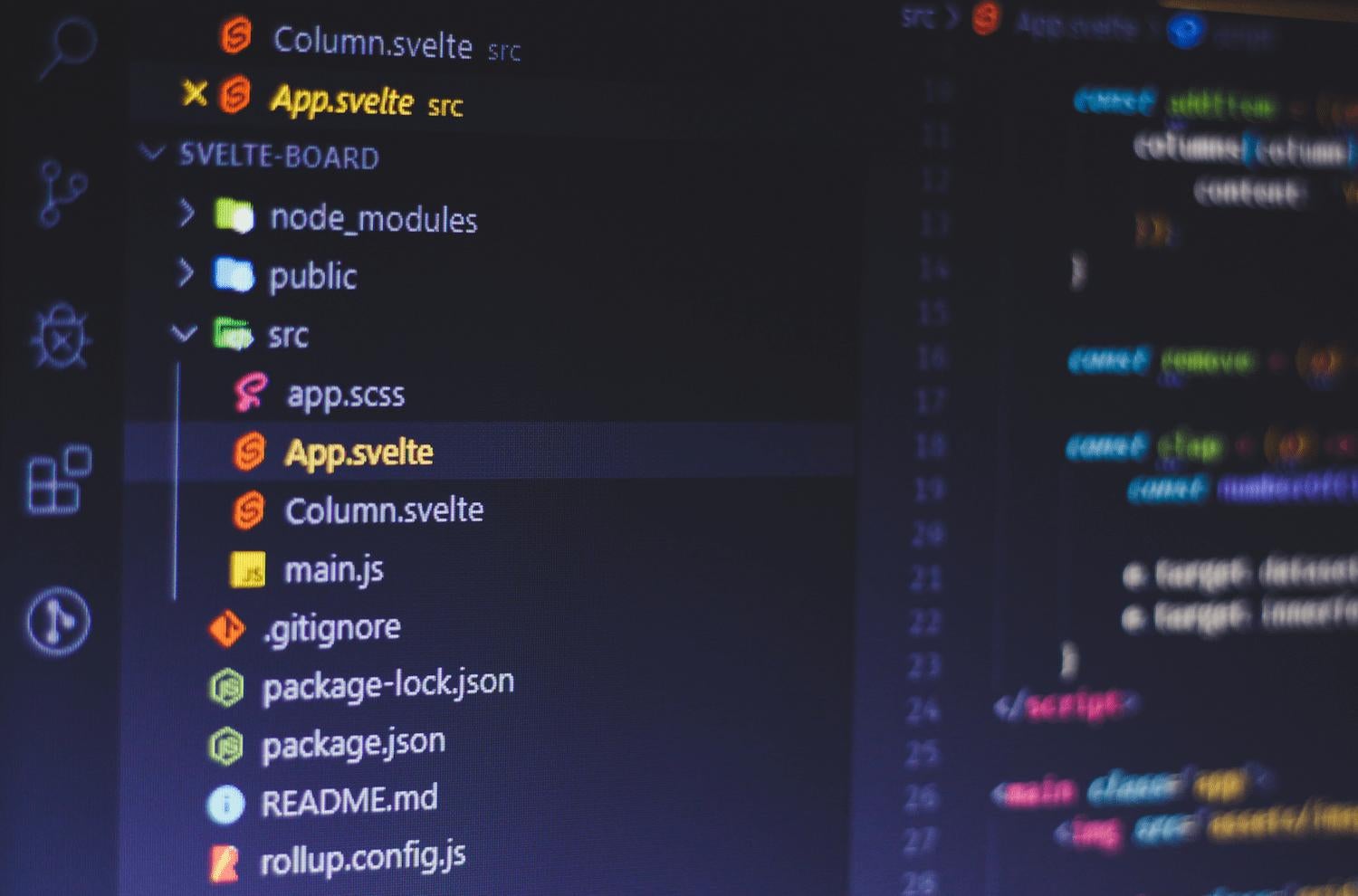It goes without saying that web development is always changing. It might be difficult to keep track of all the frameworks and libraries that are released on a regular basis.
In this article, I’m going to compare an old-timer – React – with a novice, Svelte. Both are JavaScript frameworks that have gained popularity among developers in recent years. While React has been around for a while and has a larger community, Svelte offers a unique approach to building web applications with its focus on performance and ease of use.
Which programming framework would be best suited to your needs? Let’s find out.
What is Svelte?
Svelte is a front-end, open-source JavaScript framework for building interactive websites. Enabling programmers to construct web applications, it shares certain similarities with popular frameworks like React and Vue. Svelte, however, distinguishes itself with a variety of characteristics that provide developers with a unique experience, including less code, no virtual DOM, and true reactivity.
Svelte is one of the lightest and quickest frontend frameworks. It was created by Rich Harris, a graphics editor for The New York Times, and released in November 2016. It's noted for being fast-performing as all of the framework's work is done during the build step, leaving less work for the browser. It is also renowned for providing excellent developer experiences that enable engineers to produce value more quickly and with minimal framework overhead. Even novice programmers can join a Svelte project with ease.
Svelte is a relatively new product on the market, but developers are in favour of its approach It has a loyal following and it was chosen as StackOverflow's most beloved framework.
What is React?
React is a free JavaScript library for creating user interfaces based on components. It is maintained by Meta (formerly Facebook) and a community of individual developers and companies. It was created by Jordan Walke, a Facebook programmer, and inspired by the PHP extension – XHP.
The main distinguishing feature of the React.js library is the virtual DOM. React stores the entire DOM of the application in memory, when it changes state, it looks for differences between virtual DOM objects and updates the real DOM only when required. The second special feature of React is the JSX language. It is an overlay on JavaScript that adds the ability to insert HTML code (or React components) directly in the code, instead of building them manually.
React has emerged as one of the most used JavaScript libraries. It is utilized by some of the world's largest companies, such as Facebook, Netflix, and Airbnb. React's popularity can be attributed to its robust features and versatility, which enable developers to make UIs that are incredibly interactive and responsive. What is more impressive – you can create both a web app and a mobile app in the same piece of code.

Svelte vs React – Key Differences
#1 Performance
Both provide developers with the tools they need to create incredible user experiences, but how do they compare in terms of performance? To answer this question, let’s take a closer look at Svelte vs. React in terms of performance.
Regarding speed and efficiency, Svelte is often said to be superior to React. It compiles your code to pure DOM instructions, with little to no framework code. With most decisions made upfront, your pages load quickly and smoothly for users. Additionally, as all code is compiled upfront, there’s no need for virtual DOM operations, which makes it particularly well-suited for high-performance applications such as gaming or streaming services.
#2 Smaller build bundle size
The delivered bundle size of an identical application created using React is 41.2 kB, whereas the same application created with Svelte is 2.1 kB—nearly a 20x difference!
What exactly does it mean? Developers who want to create lightweight applications should opt for Svelte, as it delivers tremendous performance benefits for users and developers alike. Also, it enables quick rendering speed and efficient loading times, which might be crucial when developing applications for smartphones or tablets.
However, if you’re looking for a perfect framework for a more complicated project, React may be the best one to choose.
#3 Tooling & Resources
Svelte provides a user-friendly library that ensures high reactivity and performance. As a compiler, it works efficiently, compiling parts to plain JavaScript at build time. With its loader, developers may easily integrate their code into existing applications without substantial difficulties. And I also have to mention the compact size that makes it a fantastic option for mobile apps.
At the same time, we cannot underestimate our old-timer. React is a preferred alternative among developers since it provides more possibilities than ever before. React has been around a little longer and is today the undisputed ruler of JavaScript frameworks. It has a ton of user- and business-created packages which come in handy for new and experienced developers.
#4 Maintenance
React outperforms Svelte in terms of maintenance since Facebook is in charge of it and the framework has a dedicated staff that works around the clock to keep it up to date. React.js has had numerous significant new releases, making it the best framework for everyone to use. We have witnessed the releases of functional components, React Context, Hooks, etc., making React more versatile.
However, don’t get me wrong – Rich Harris, the creator of Svelte, is directly supported by Vercel, one of the biggest providers of cloud services, to maintain and develop the framework full time. With extensive open-source community support, its longevity on the market is assured.
#5 Ease of Learning
Considering its relative simplicity, Svelte is frequently seen to be simpler to learn than React. As one of the more recent frameworks available, it provides fewer complicated and complex capabilities that demand in-depth understanding and more advanced knowledge. Its coding style also resembles that of pure JavaScript, so learning curves for new developers switching from HTML and CSS to JS-based programming are reduced. Nevertheless, despite its simplicity, it is as powerful, robust, and as easy to maintain as React.
#6 Community
In terms of having access to a large community, React appears to be a better option. Learning how to utilise a new development tool might be daunting if you can't get the help you need. Fortunately, it is not an issue with React. Not only is it the chosen technology by leading organizations, but React also enjoys popularity among developers.
Svelte, as quite a novice, didn’t have that much time to collect such a robust group of enthusiasts. However, even though it’s not as popular as React, it managed to win the affection of developers and is regarded as one of the most loved frameworks.

Recommendations
Regarding front-end development, each framework has its benefits and drawbacks. You should think about the kind of website or web app you want to create as well as the resources that are available. Here are a few suggestions.
Svelte works best when developing:
- Minimum Viable Products (MVPs)
- Mobile first web applications
- Fast static web apps
- Responsive landing pages
- Custom code and reusable components to integrate into other web apps.
React, on the other hand, is advantageous for:
- frontend UI that demands high user interaction
- high-volume, performant applications
- websites with complex user interfaces
- shared codebase between web and mobile apps.
Read also: Svelte vs. Vue – Which Framework Fits Your Business Best?
How to Choose between Svelte and React?
The choice is yours and depends on what exactly you plan to work on. Svelte is a good choice for those who value performance and want to build web apps with minimal overhead, while also enjoying a simpler and more intuitive development experience. It can be very helpful for smaller projects or ones that focus on speed and ease of development. Therefore, if you're looking for a lightweight and efficient framework that prioritizes speed and simplicity, Svelte is definitely worth considering.
One of the primary reasons to adopt React is its extensive ecosystem and community support, which offers a diverse set of tools and libraries to boost development efficiency. React is the best option for web developers who want to create complex and interactive user interfaces with ease, as it provides a declarative programming style and efficient rendering, especially when working on a mobile app at the time as well.
We have hopes that the information provided in this article will help you determine if React is the right solution for your project or if Svelte is a better alternative. Ultimately, it depends on your specific needs and preferences as a developer, so it's important to do your research and weigh the pros and cons of each framework before making a decision.
However, if you're still not sure which technology to choose for your digital product, feel free to contact us. With our extensive experience, we can easily find the best solution for you.



